| A more thoughtful version of the income-doesn't-matter argument surfaces in my former Slate colleague Mickey Kaus' 1992 book The End of Equality. Kaus chided "Money Liberals" for trying to redistribute income when instead they might be working to diminish social inequality by creating or shoring up spheres in which rich and poor are treated the same. Everybody can picnic in the park. Everybody should be able to receive decent health care. Under a compulsory national service program, everybody would be required to perform some civilian or military duty. As a theoretical proposition, Kaus' vision is appealing. Bill Gates will always have lots more money than me, no matter how progressive the tax system becomes. But if he gets call! ed to jury duty he has to show up, just like me. When his driver's license expires, he'll be just as likely to have to take a driving test. Why not expand this egalitarian zone to, say, education, by making public schools so good that Gates' grandchildren will be as likely to attend them as mine or yours? But at a practical level, Kaus' exclusive reliance on social equality is simply inadequate. For one thing, the existing zones of social equality are pretty circumscribed. Neither Gates nor I spend a lot of time hanging around the Department of Motor Vehicles. Rebuilding or creating the more meaningful spheres—say, public education or a tr! uly national health care system—won't occur overnight. Nurturing the social-equality sphere isn't likely to pay off for a very long time. Kaus would like to separate social equality from income equality, but the two go hand in hand. In theory they don't have to, but in practice they just do. Among industrialized nations, those that have achieved the greatest social equality are the same ones that have achieved the greatest income equality. France, for example, has a level of income inequality much lower than that of most other countries in the Organization for Economic Cooperation and Development. It's one of the very few places where income inequality has been going down. (Most everywhere else it's gone up, though nowhere to the degree it has in the United States.) France also enjoys what the World Health Organization calls the world's finest! health care system (by which the WHO means, in large part, the most egalitarian one; this is the famous survey from 2000 in which the U.S. ranked 37th). Do France's high marks on both social equality and income equality really strike you as a coincidence? As incomes become more unequal, a likelier impulse among the rich isn't to urge or even allow the government to create or expand public institutions where they can mix it up with the proles. It's to create or expand private institutions that will help them maintain separation from the proles, with whom they have less and less in common. According to Jonathan Rowe, who has written extensively about social equality, that's exactly what's happening in the United States. In an essay titled "The Vanishing Commons" that appeared in ! Inequality Matters, a 2005 anthology, Rowe notes that Congres s has been busy extending copyright terms and patent monopolies and turning over public lands to mining and timber companies for below-market fees." In an 'ownership' society especially," Rowe writes, "we should think about what we own in common, not just what we keep apart." Inequality doesn't create unhappiness. Arthur C. Brooks, president of the American Enterprise Institute, argued this point in National Review online in June. What drives entrepreneurs, he wrote, is not the desire for money but the desire for earned success. When people feel they deserve their success, they are happy; when they do not, they aren't. "The money is just the metric of the value that the person is creating." Brooks marshaled very little evidence to support his argument, and what evidence he did muster was less impressive than he thought. He made much of a 1996 survey that asked people how suc! cessful they felt, and how happy. Among the 45 percent who counted themselves "completely successful" or "very successful," 39 percent said they were very happy. Among the 55 percent who counted themselves at most "somewhat successful," only 20 percent said they were happy. Brooks claimed victory with the finding that successful people were more likely to be happy (or at least to say they were), by 19 percentage points, than less-successful people. More striking, though, was that 61 percent of the successful people—a significant majority—did not say they were "very happy." Nowhere in the survey were the successful people asked whether they deserved their happiness. Let's grant Brooks his generalization that people who believe they deserve their success are likelier to be happy than people who believe they don't. It makes intuitive sense. But Brooks' claim that money is only a "metric" does not. Looking at the same survey data, B erkeley sociologist Michael Hout found that from 1973 to 2000 the difference between the affluent and the poor who counted themselves either "very happy" or "not too happy" ranged from 19 percentage points to 27. Among the poor, the percentage who felt "very happy" fell by nearly one-third from 1973 to 1994, then crept up a couple of points during the tight labor market of the late 1990s. Hout also observed that overall happiness dropped a modest 5 percent from 1973 to 2000. Quality of life is improving. This argument has been made by too many conservatives to count. Yes, it's true that an unemployed steelworker living in the 21st century is in many important ways better off than the royals and aristocrats of yesteryear. Living conditions improve over time. But people do not experience life as an interesting moment in the evolution of human societies. They experience it in the present and weigh their own experience against that of the livin! g. Brooks cites (even though it contradicts his argument) a famous 1998 study by economists Sara Solnick (then at the University of Miami, now at the University of Vermont) and David Hemenway of the Harvard School of Public Health. Subjects were asked which they'd prefer: to earn $50,000 while knowing everyone else earned $25,000, or to earn $100,000 while knowing everyone else earned $200,000. Objectively speaking, $100,000 is twice as much as $50,000. Even so, 56 percent chose $50,000 if it meant that would put them on top rather than at the bottom. We are social creatures and establish our expectations relative to others. Inequality isn't increasing. This is the boldest line of conservative attack, challenging a consensus about income trends in the Unit! ed States that most conservatives accept. (Brooks: "It is factually incorrect to argue that income inequality has not risen in America—it has.") Alan Reynolds, a senior fellow at Cato, made the case in a January 2007 paper. It was a technical argument hinging largely on a critique of the tax data used by Emmanuel Saez and Thomas Piketty in the groundbreaking paper we looked at in our installment about the superrich. But as Gary Burtless of Brookings noted in a January 2007 reply, Social Security records "tell a simple and similar story." A Congressional Budget Office analysis, Burtless wrote, addressed "almost all" ! of Reynolds' objections to Saez and Piketty's findings, and confirmed "a sizable rise in both pre-tax and after-tax inequality." Reynolds' paper didn't deny notable increases in top incomes, but he argued that these were because of technical changes in tax law and/or to isolated and unusual financial events. That, Burtless answered, was akin to arguing that, "adjusting for the weather and the season, no homeowner in New Orleans ended up with a wet basement" after Hurricane Katrina. That income inequality very much matters is the thesis of the 2009 book The Spirit Level, by Richard Wilkinson and Kate Pickett, two medical researchers based in Yorkshire. The book has been criticized for overreaching. Wilkinson and ! Pickett relate income inequality trends not only to mental and physica l health, violence, and teenage pregnancy, but also to global warming. But their larger point—that income inequality is bad not only for people on the losing end but also for society at large—seems hard to dispute. "Modern societies," they write, will depend increasingly on being creative, adaptable, inventive, well-informed and flexible communities, able to respond generously to each other and to needs wherever they arise. These are characteristics not of societies in hock to the rich, in which people are driven by status insecurities, but of populations used to working together and respecting each other as equals.
The United States' economy is currently struggling to emerge from a severe recession brought on by the financial crisis of 2008. Was that crisis brought about by income inequality? Some economists are starting to think it may have been. David Moss of Harvard Business School has produced an intriguing chart that shows bank failures tend to coincide with periods of growing income inequality. "I could hardly believe how tight the fit was," he told the New York Times. Princeton's Paul Krugman has similarly been considering whether the Great Divergence helped cause the recession by pushing middle-income Americans into debt. The growth of household debt has followed a pattern strikingly similar to the growth in income inequality (see the final graph). Raghuram G. Rajan, a business school professor at the University of Chicago, recently argued on the New Republic's Web site that "let them eat credit" was "the mantra of the political establishment in the go-go years before the crisis." Christopher Brown, an economist at Arkansas State University, wrote a paper in 2004 affirming that "inequality can exert a significant drag on effective demand." Reducing inequality, he argued, would also reduce consumer debt. Today, Brown's paper looks prescient. Heightened partisanship in Washington and declining trust in government have many causes (and the latter slide predates the Great Divergence). But surely the growing income chasm between the poor and middle class and the rich, between the Sort of Rich and the Rich, and even between the Rich and the Stinking Rich, make it especially difficult to reestablish any spirit of e pluribus unum. Republicans and Democrats compete to show which party more fervently opposes the elite, with each side battling to define what "elite" means. In a more equal society, the elite would still be resented. But I doubt that opposing it would be an organizing principle of politics to the same extent that it is today. I find myself returning to the gut-level feeling expressed at the start of this series: I do not wish to live in a banana republic. There is a reason why, in years past, Americans scorned societies starkly divided into the privileged and the destitute. They were repellent. Is it my imagination, or do we hear less criticism of such societies today in the United States? Might it be harder for Americans to sustain in such discussions the necessary sense of moral superiority? What is the ideal distribution of income in society? I couldn't tell you, and historically much mischief has been accomplished by addressing this question too pre! cisely. But I can tell you this: We've been headed in the wrong direct ion for far too long. View a visual guide to inequality. Subscribe to this series. Navigate the series from a single page. Become a fan of Slate on Facebook. Follow us on Twitter. Timothy Noah is a senior writer at Slate.Article URL: http://www.slate.com/id/2266025/ |



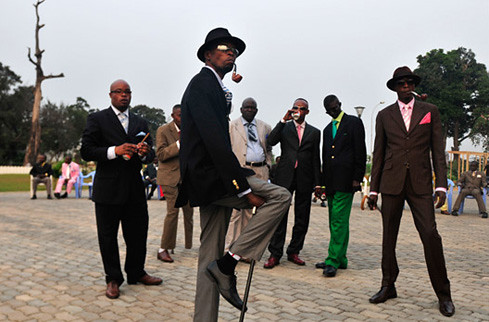
 The special relationship between black men and dandyism arose with slavery in Europe particularly during England’s Enlightenment period. In early 18th century, masters who wanted their slaves to reflect their social stature imposed dandified costumes on black servants, effectively turning them into ‘luxury slaves’. As black slaves gained more liberty, they took control of the image by customising their dandy uniforms and thereby creating a unique style. They transformed from black men in dandy clothing to dandies who were black.
The special relationship between black men and dandyism arose with slavery in Europe particularly during England’s Enlightenment period. In early 18th century, masters who wanted their slaves to reflect their social stature imposed dandified costumes on black servants, effectively turning them into ‘luxury slaves’. As black slaves gained more liberty, they took control of the image by customising their dandy uniforms and thereby creating a unique style. They transformed from black men in dandy clothing to dandies who were black. One of the pioneers of black dandies in England was Julius Soubise, a fencing master, poet and actor who was once owned by the Duchess of Queensbury. Julius Soubise would appear at London’s high society venues wearing “red-heeled diamond-buckled shoes and buttock-skimming breeches”.
One of the pioneers of black dandies in England was Julius Soubise, a fencing master, poet and actor who was once owned by the Duchess of Queensbury. Julius Soubise would appear at London’s high society venues wearing “red-heeled diamond-buckled shoes and buttock-skimming breeches”. As that is a mouthful so it is just SAPE. “Sape” comes from a French slang that means “dressing with class” and the term Sapeur is an African word that refers to someone that is dressed with great elegance. The Sapeurs as the name suggests are elegant and stylish men from Congo who roam the streets of Brazzaville and Bacongo in Western suits and usually with cigars, and the occasional pipe, between their lips. These are men who are so obsessed with looking good and designer clothes that they sometimes place more importance on clothes than anything else.
As that is a mouthful so it is just SAPE. “Sape” comes from a French slang that means “dressing with class” and the term Sapeur is an African word that refers to someone that is dressed with great elegance. The Sapeurs as the name suggests are elegant and stylish men from Congo who roam the streets of Brazzaville and Bacongo in Western suits and usually with cigars, and the occasional pipe, between their lips. These are men who are so obsessed with looking good and designer clothes that they sometimes place more importance on clothes than anything else.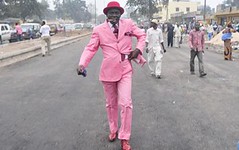 This moral code, however, also had a political motive. Papa Wemba initially introduced the culture as a challenge to the strict dress codes that were imposed by the government at that time who effectively outlawed Western styles of dress. In 1974 after the DRC had recently come out of colonisation and had gained its independence from France, the government lead by Mobutu Sese Seko banned all European and Western styles of imported clothing in favour of a return to traditional African clothing. Papa Wemba challenged these strict dress codes by insisting that it should be a pleasure rather than a crime to wear clothes from Paris and by setting an example for impressionable young men by dressing outlandishly. At this time, the culture also was heavily associated with music, since Papa Wemba supported young talented musicians such as Koffi Olomide.
This moral code, however, also had a political motive. Papa Wemba initially introduced the culture as a challenge to the strict dress codes that were imposed by the government at that time who effectively outlawed Western styles of dress. In 1974 after the DRC had recently come out of colonisation and had gained its independence from France, the government lead by Mobutu Sese Seko banned all European and Western styles of imported clothing in favour of a return to traditional African clothing. Papa Wemba challenged these strict dress codes by insisting that it should be a pleasure rather than a crime to wear clothes from Paris and by setting an example for impressionable young men by dressing outlandishly. At this time, the culture also was heavily associated with music, since Papa Wemba supported young talented musicians such as Koffi Olomide.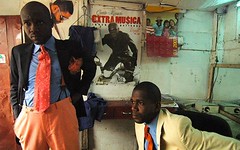 At the height of his success, Papa Wemba had established a “village” comprising his family home and the surrounding streets in which the strict Sapeur code was enforced. Youths and musicians visited this village to acquire cool points while Papa Wemba reigned as “chief”. All other sorts of positions exist among the Sapeurs such as “high priest of cloth” and “chancellor of designer labels” positions which are based on personal flamboyance and the size of expensive wardrobes.
At the height of his success, Papa Wemba had established a “village” comprising his family home and the surrounding streets in which the strict Sapeur code was enforced. Youths and musicians visited this village to acquire cool points while Papa Wemba reigned as “chief”. All other sorts of positions exist among the Sapeurs such as “high priest of cloth” and “chancellor of designer labels” positions which are based on personal flamboyance and the size of expensive wardrobes. For example, the cigar which is the ultimate symbol for the Sapeur is considered to give added value to the outfit. While some Sapeurs never smoke their cigars, those who do are required to ask their neighbours if it is okay for them to light their cigars even though they may not be in a non-smoking area.
For example, the cigar which is the ultimate symbol for the Sapeur is considered to give added value to the outfit. While some Sapeurs never smoke their cigars, those who do are required to ask their neighbours if it is okay for them to light their cigars even though they may not be in a non-smoking area.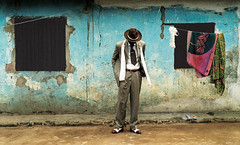 While reading about Sapeurs elsewhere online, a lot of emphasis seems to be placed on the fact that most of the men who are part of this subculture come from very impoverished communities. There is lot of talk on just how far these men go in order to buy an expensive suit and how the SAPE is a form of escapism for “poor downtrodden African youths”. The discrepancy between the elegance and style that make a Sapeur and the poor conditions of living are shown as a clash of worlds.
While reading about Sapeurs elsewhere online, a lot of emphasis seems to be placed on the fact that most of the men who are part of this subculture come from very impoverished communities. There is lot of talk on just how far these men go in order to buy an expensive suit and how the SAPE is a form of escapism for “poor downtrodden African youths”. The discrepancy between the elegance and style that make a Sapeur and the poor conditions of living are shown as a clash of worlds. For more information, click on any of the linked images above. Also, check out this great photo essay,
For more information, click on any of the linked images above. Also, check out this great photo essay, 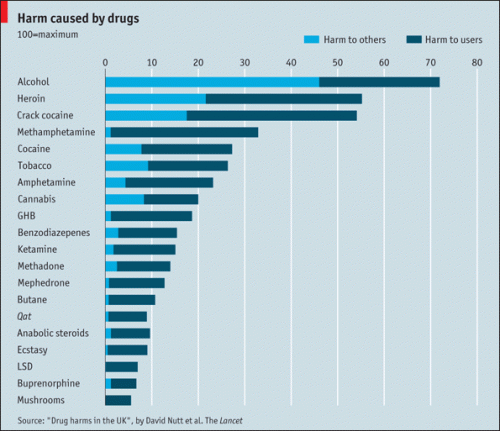

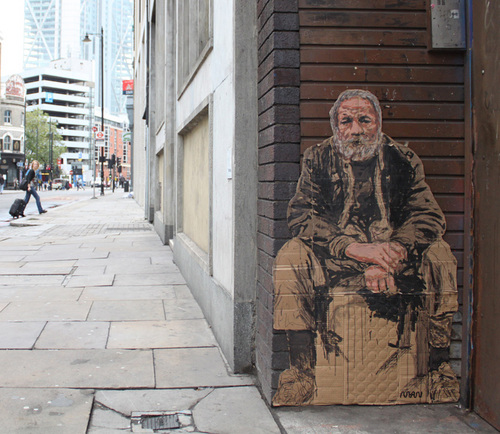

 This new video comes from Mark's InvisiblePeople.tv
This new video comes from Mark's InvisiblePeople.tv 




